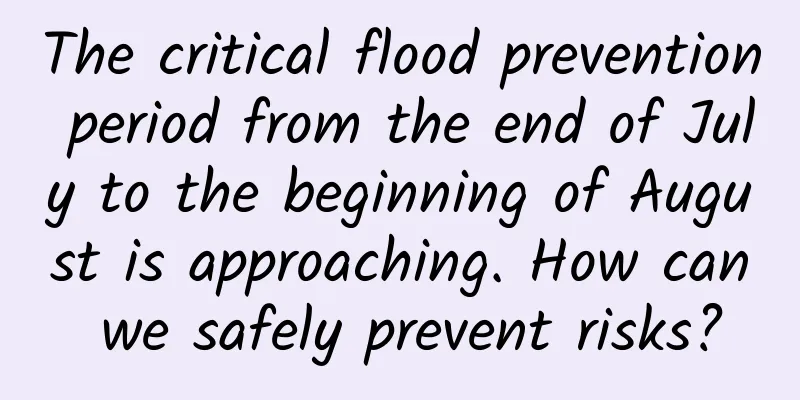The critical flood prevention period from the end of July to the beginning of August is approaching. How can we safely prevent risks?

|
China has fully entered the main flood season and is about to usher in the critical flood prevention period of "the end of July and the beginning of August" . According to forecasts and analysis, during this critical flood prevention period, China's climate conditions will be generally abnormal, with more extreme weather and climate events, more rainfall in the eastern region, and more obvious regional and periodic flood disasters. The flood situation report released by the Ministry of Water Resources shows that according to the forecast, my country has entered the critical flood prevention period of "the end of July and the beginning of August". Drought and floods will occur simultaneously, and floods will be more serious than drought. Extreme emergencies such as rainstorms and floods will become more frequent, wider, stronger, and have serious impacts. The upper reaches of the Yangtze River, the middle and lower reaches of the Yellow River, the Yi River and Shuhe River in the Huaihe River Basin, the Zhangwei River and Ziya River in the Haihe River Basin, the Songhua River, and the Liaohe River may have severe flood conditions. There may be 2 to 3 typhoons making landfall, which is close to the annual average to more than usual, and the intensity is strong. There is a possibility that a typhoon will move north and cause disasters. A must-read during the flood season! A guide to avoiding risks and saving yourself During the critical flood prevention period, early evacuation is an important part of disaster prevention and mitigation . In addition to paying close attention to the rainfall and flood warning information issued by the meteorological department through mobile phones, television, radio and other channels, it is also necessary to keep abreast of the rainfall and river water levels in your area and upstream and downstream so as to respond in a timely manner. Prepare emergency supplies in advance Daily necessities: Stock up on sufficient food, drinking water, clothing, medicine, and emergency items such as flashlights, whistles, raincoats, etc. Communication equipment: Make sure that mobile phones, power banks and other communication equipment are sufficiently charged so that you can contact the outside world in an emergency. Develop a risk-avoidance plan Family plan: Family members should jointly develop a transfer and evacuation plan, clearly defining the gathering place, evacuation route and contact information. High-risk areas: People living in high-risk areas such as low-lying areas, river banks, and mountainous areas should be moved to safe areas in advance. If you need to evacuate on foot, try to avoid flooded areas and take shelter in high ground or sturdy buildings. Avoid touching objects that may conduct electricity, such as electric poles and trees, to prevent electric shock. Comply with government directives Obey orders: Once you receive an order from the government to evacuate or move to a safe place, you should act immediately without delay. Orderly evacuation: Evacuate in an orderly manner according to the designated evacuation routes and assembly points to avoid causing chaos and congestion. Pay attention to secondary disasters Landslides and mudslides : Rainfall can easily trigger landslides and mudslides. People living in mountainous areas or surrounding areas should be particularly vigilant, pay close attention to changes in the mountains, and evacuate immediately if any abnormalities are found. Urban waterlogging : Urban waterlogging is also one of the common secondary disasters. Residents living in low-lying areas or areas with poor drainage should take preventive measures in advance. If you encounter heavy rain while driving, try to avoid driving. If you must travel, pay attention to road conditions and avoid wading to prevent your vehicle from being flooded. Improve disaster prevention and risk avoidance awareness and self-rescue and mutual rescue capabilities Be the first person responsible for the safety of yourself and your family Comprehensive sources: Xinhua News Agency, Ministry of Emergency Management, etc. |
<<: Does the height of the exam room's ceiling affect test scores? New study: This may be true!
>>: Nature sub-journal: Subverting cognition! Do we really need to be "brainwashed"?
Recommend
Event promotion: A collection of 54 event cases for the 2019 Spring Festival!
During the Spring Festival, major Internet platfo...
New APP features are launched, those trivial methods can leverage the overall situation
We have discussed the work that operations need t...
10 Taobao operation tips to increase your store’s popularity!
What are the Taobao operation skills? Sometimes T...
Electric Technology Car News: With Trumpchi in front and Haval behind, how far can Dongfeng Tianyi go in the SUV market just by relying on appearance?
There is an old saying: You can't have your c...
Look at how the ancients celebrated New Year’s Day, that’s how we celebrate a festival!
New Year Come with the New Year's vigor Come ...
In-depth case analysis of UNIQLO brand marketing
UNIQLO is one of the brands we focus on in our re...
How can brands use TikTok efficiently? Try this method!
Recently, a friend from the brand marketing depar...
How much does it cost to be a tea mini program agent in Hexian market?
Is it easy to be an agent of Hexian Tea Mini Prog...
Get APP growth analysis report
1. Background and Purpose background Recently, I ...
Why are there vitamins E and K, but no vitamins FG, H, I, and J?
We are all familiar with vitamins ABCDE, but if w...
Xigua Video Product Analysis Report
Watching videos in free time has become an entert...
App download volume is too low? You should collect product issues
How to discover product problems from users and i...
10 ways to attract new members in the education industry
I don’t know since when, a community trend has em...
Can these 6 truths save your sleep?
Do you remember when you first suffered from inso...
How to be immune to fake traffic?
In recent years, China's Internet has faced a...









